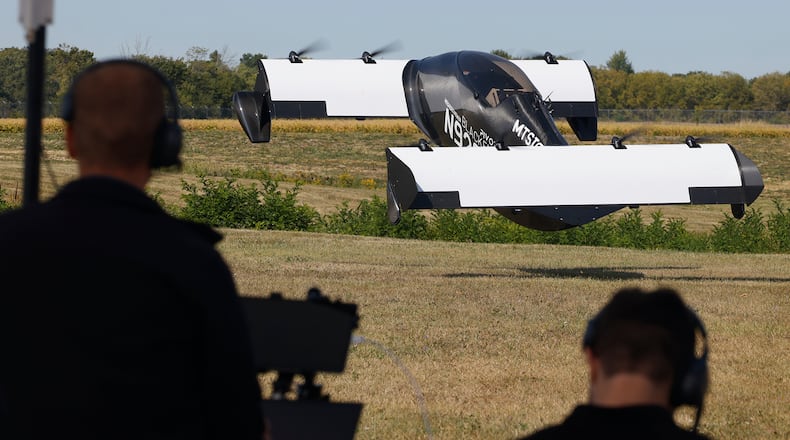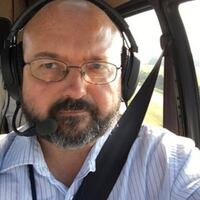“It’s gotten really big,” Johnson said in an interview in his office at Sinclair’s building 12, a reference both to Sinclair’s program and the size of the aircraft with which Sinclair works.
Asked how much Sinclair has seen in revenue, contracts and grants from its work with drones, Johnson said: “More than our expenses.”
From fiscal years 2021 to 2025, Sinclair expects to see a total of $4.8 million in revenue from its unmanned aerial systems business, according to figures the college provided this news outlet. Over that time, Sinclair will have worked with more than 200 public and private clients.
“It’s an amazing story, what they have done,” said retired Air Force Col. Stephen Luxion, executive director of ASSURE (the Alliance for System Safety of UAS through Research Excellence).
ASSURE members, such as Sinclair, help the Federal Aviation Administration do the research and testing needed to craft aviation laws and regulations.
“Not only are they (Sinclair) involved, they are highly respected in this space,” Luxion said.
‘We will go anywhere on the earth’
School leaders say Sinclair has come a long way since 2015, when the Ohio Controlling Board approved $4 million toward remodeling the school’s building 13 into a training and testing facility for unmanned aerial systems, often called “drones.”
Nearly a decade later, the college teaches both students and professionals about the drone industry — how to operate drones and when they might be used — while stepping into the arena of advanced air mobility aircraft or eVTOLs — larger, electric aircraft that can nimbly launch from and land on a single location, without a runway and with relatively little noise.
Especially in the latter area, Sinclair helps the Air Force, NASA, the Federal Aviation Administration (FAA) and private companies answer questions about uses and technological limits.
Credit: Bill Lackey
Credit: Bill Lackey
The college can help companies build out capabilities, acquire aircraft, develop training curricula and more.
In its business, Sinclair has inked agreements with original equipment manufacturers in France, Switzerland, the United Kingdom and beyond.
“We will go anywhere on the Earth to find who has the primary technology in these spaces to partner with,” said Jeff Miller, the college’s senior vice president overseeing UAS and advanced air mobility work.
Credit: Bill Lackey
Credit: Bill Lackey
Sinclair’s first two bachelor’s degrees were in this area — a bachelor’s of applied science degrees in aviation technology and commercial piloting and UAS, Johnson said. (The school also offers four-year degrees in nursing and integrated systems, or information technology.)
The school is doing more than building academic programs, as college leaders describe the work. Sinclair staff members develop models to help the FAA understand how air taxis (or eVTOLs) will fit in air traffic over the next 25 years. It works on cyber-security for the NSA (the National Security Agency), and advanced air mobility for NASA.
“All kinds of letters and acronyms,” quipped Andrew Shepherd, Sinclair’s chief scientist for UAS.
This year, Sinclair partnered with Beavercreek defense contractor Modern Technology Solutions Inc., or MTSI, in MTSI’s work for the Air Force.
MTSI reached out to Sinclair after the business reached an agreement with Silicon Valley aviation technology company Pivotal in February to test Pivotal’s distinctive “BlackFly” eVTOL craft for the Air Force.
“It was a really good fit,” Shepherd said.
On its end, Sinclair brought the staff experience, bringing forward senior pilots with experience in crewed aircraft to operators of much smaller drones.
Two weeks of training on the Pivotal aircraft in Palo Alto, Calif. followed, with test flights beginning at Springfield-Beckley Municipal Airport in early June.
MTSI’s goal was to “validate” the technology for the Air Force while demonstrating some potential uses for a vehicle like the BlackFly. Can these vehicles prove useful for carrying cargo? For rescuing downed airmen? For quick and quiet intelligence flights?
Some 150 sorties (or flights) with the BlackFly have taken place this summer, about 24 hours of total flying time, Sinclair staff said.
Credit: Bill Lackey
Credit: Bill Lackey
Drivers on West Blee Road near the airport have seen the BlackFly — which, from an angle, looks somewhat like a metallic insect — flying and dipping over soybean fields and runways, eerily quiet all the while.
Sinclair has more people trained on the BlackFly than any other organization, Johnson said.
Among the questions MTSI is trying to answer for the Air Force: How easy these kinds of craft are to fly — and how hard they are to master.
“An advantage of using an external third party like Sinclair as a sub (-contractor) to MTSI is it also gave them another testing avenue,” Shepherd said. “How do people who don’t know anything about that particular aircraft come in from zero, get trained on it and then do that testing process?”
“Sinclair likes to lean forward on things,” Miller said.
Flying the BlackFly
Tests like those of the BlackFly at the National Advanced Air Mobility Center of Excellence at Springfield-Beckley Airport also help shed light on how Sinclair can help industry customers, Shepherd said. What does the industry need? What can today’s technology accomplish?
“It is fun,” said John Bohun, Sinclair’s associate director for advanced air mobility training and the college’s lead test pilot.
The BlackFly is “very easy to fly,” he said. “It’s designed to be very easy to fly.”
Simplified flight control systems on the BlackFly assist with the critical phases of taking off and landing, Bohun said.
But flying precise patterns and exploring possible uses is more challenging. Types of take-offs, landings and jaunts to certain altitudes are all carefully gauged.
Credit: Bill Lackey
Credit: Bill Lackey
“How is it meeting the criteria that we have set forth for each of these flights?” Bohun said. “We’ll do that many times to gather data points.”
“All these flights are very purposeful,” Miller said.
Six BlackFly airframes — five that are flyable and a sixth “demonstration bird” ready for disassembly and reassembly — called the Springfield-Beckley airport home this summer. Testing wrapped up at the end of the September.
Pivotal is selling the craft, and Sinclair is in talks to buy one, since the school has five people trained to operate the craft, Shepherd said.
And no: It isn’t crazy to wonder if one day Sinclair students will learn to fly them, he said.
“We could have either workforce training for incumbent workers where people are getting trained to operate in-cockpit or out, and certainly eventually you could have credit students involved, as well,” he said.
‘It’s something new’
Sept. 9 was a demonstration day at the Springfield airport for area STEM students who are homeschooled or attending the Greene County Career Center.
Amanda Warren, program manager at Sinclair for commercialization and technology transfer, watched as students checked out eVTOLs (electric vertical takeoff and landing) vehicles or tried out a BlackFly flight simulator.
Credit: Bill Lackey
Credit: Bill Lackey
“Who wants to go first?” Sinclair UAS pilot Cameron Smock asked a group of homeschoolers gathered around the flight simulator, which offered users virtual reality goggles and a mobile chair to provide a dramatic sense of motion.
Sinclair has a team that visits middle-schools, talking classes through drone uses and how digital tools help companies and the military manage the lifespan of equipment.
But time on the simulator is probably most popular for students, Warren said.
Sinclair’s goal is to give students a glimpse “of the possibilities they have moving forward in career paths,” she said.
“It’s something new,” she said. “It’s not something they see every day.”
Sam Onyett, a Sinclair program technician, said students typically ask questions about craft weights and capabilities.
“Someone asked me if drones will take over the world,” Onyett said with a smile. “I told them I wouldn’t worry about it.”
About the Author







